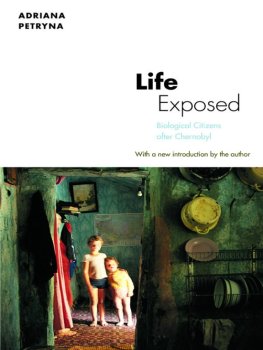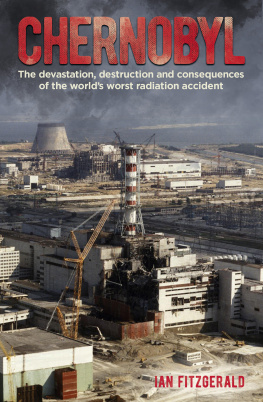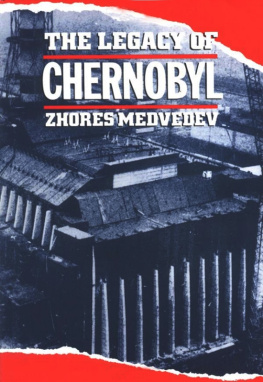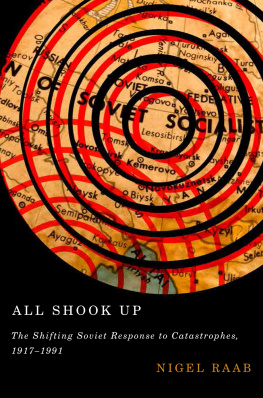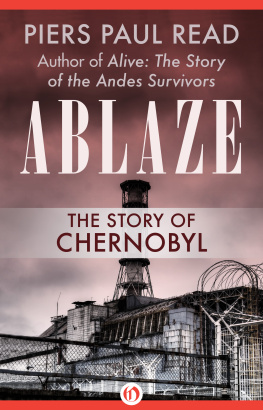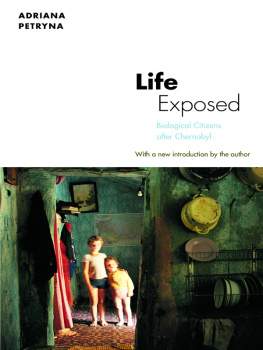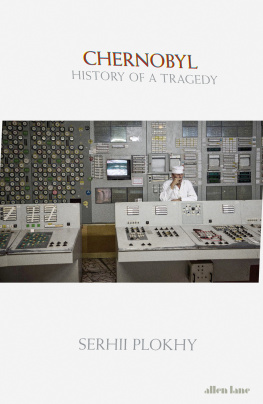Adriana Petryna
LIFE EXPOSED
Biological Citizens after Chernobyl
With a new introduction by the author
Introduction to the 2013 Edition: How Did They Survive?
They are alive. The workers know that they didnt die. But they dont know how they survived. These words were spoken to me by a biochemist in Kyiv, Ukraine, in 1996, a decade after the nuclear disaster at Chernobyl. This scientist, along with colleagues at the countrys Academy of Medical Sciences, pioneered a way of analyzing the tooth enamel of Chernobyl cleanup workers and evacuees for clues to past levels of radiation exposure. Affected populations included roughly 600,000 cleanup workers and 5 million people either resettled from contaminated territories or continuing to live there. Their actual doses were uncertain or unknown owing to a lack of monitoring, and this made long-term research on Chernobyls health effects difficult, but not impossible. Tooth enamel, scrubbed of organic rot and crushed into microfine mineral components, provides a reliable measurement of an absorbed dose. More than four thousand samples were gathered in an established countrywide tooth acquisition network. Dr. Vadim Chumak and his colleagues, supported partly by the U.S. Armed Forces Radiobiology Research Institute, worked tirelessly, analyzing the dosimetric signals of the prepared samples so that a large-scale epidemiological study could soon take place. At least that was the plan.
Dr. Chumak expressed surprise, even bewilderment, at some of his research subjects even being alive. Samples from some Chernobyl cleanup workers showed that they had absorbed six to eight times the textbook definition of a lethal dose of radiation. Their teeth evidenced the unthinkable: improbable lives for whom the textbook of survival was not yet written.
More than twenty-five years later, that textbook still does not exist. The research networks required to translate Chernobyl survivors reconstructed doses into an internationally recognized gold standard of clinical data have all but disintegrated. Populations affected by Chernobyl have by and large become vestiges of largerand mostly unsystematizedbodies of fragmented studies. The heterogenous facts of living that make up their stories of death and recovery have nowhere to live under dominant systems of knowledge. How they survived has become an inexplicable fluke.
Because of their durability, teeth have a special capacity to resist the pressure of disappearance. Remaining after everything else decays, fossils, like teeth, are also flukes, pointing to assemblages of life and matter and larger living environments that no longer exist; they dog the certainties of knowledge systems and the authority we attribute to them. Fossils, like the teeth, can be serendipitous tooa starting point for newer, more complete truths. Or they can signal a lost chance, in which the potential for newer, more complete truths precipitously falls away.
There is a term in science that captures this instability of what fossils mean. Introduced in 1940 by Soviet paleontologist and science fiction writer Ivan Yefremov, taphonomy (from the Greek taphos, burial; nomos, law) refers to the laws governing how biocomposites of whatever sort decayto the rules that determine how they are put away, so to speak, into the lithic world and, ultimately, cast off into geological deep time. Taphonomy also charts the circuitous paths by which fossils come back to us, how their weatherings and modifications and very depositional environments confound what they are. Fossils, ancient artifacts, ammonites, seashells, or rodent teeth, are transfigured, bored into, weathered, and altered by heatthey are never just pure samples.
Life Exposed applies this taphonomic sensibility to call for a more complete record of what happened to the cleanup workers, resettled families, and children and parents of exposed children in the decade after the Chernobyl disaster. What is the moral and epistemological system in which knowledge of Chernobyl survivors fits or precipitously drops off? Are the survivors castoffs or flukes to be discounted or filtered outnoise in the system of present-day knowledge of human radiogenic risk? Or are theythese possessors of muddled histories and truthsthe very thing to be studied? What larger assemblages of truth and disposals of truth do they reference? What is missing but somehow present in what remains? How is it that we remain ignorant about how they survived? What accounts for the incompleteness of the Chernobyl disasters fossil record?
To be sure, the unraveling of the Soviet system in 1989 contributed to an atmosphere of chaos and left a legacy in Ukraine of incomplete accounting for Chernobyls full public health and human consequences. Moreover, the difficulty of independent long-term study of the disasters human health effects has been exacerbated by fragmented research efforts and misplaced priorities, a lack of cooperation between international organizations, inconsistent funding or inappropriate allocation and misuse of funds, and the incompleteness of information and data collection.
In spite of these realities, official pronouncements two decades later convey a sense of certainty about Chernobyls human health effects.
Paralyzed by fatalism or overlooked by science? Such invocations can be taken as indexes of how far off the scientific community is from fully understanding and predicting the health consequences from Chernobyl. You do not need this book to tell you how people took all sorts of drastic measures, in the days and months after the disaster, to mitigate the consequences: sending their children by train to relatives living in unaffected areas, sealing their windows and scouring their floors, desperately scavenging for iodine pills to prevent iodine-131-induced thyroid cancers, searching for clean foods for their youngest, and even making their own dosimeters. To call these people fatalistic echoes earlier statements by the International Atomic Energy Agency (IAEA) blaming mental stress on poor understandings of scientific principles. It is to deny survivors the attention that their actions are due, and to misstate the record of what actually happened during and after the disaster.
By some curious twist of fate, the people who should be central to knowledge about Chernobyls health effects have become peripheral, even pariahs. Somehow, scientific interest in the lessons of the disaster has been satisfied in isolation from the well-being of those whose lives have been shattered by Chernobyl, against the intentions of the many scientific experts involved.
Indeed, if the atomic bomb studies provide any guidance, it is far too soon to measure Chernobyls full impact. In the words of one report, In 1965, 20 years after the atomic bombings in Japan, the Atomic Bomb Casualty Commission reported significant increases in the incidence of just two cancersthyroid cancer and leukemia among the some eighty thousand Japanese bomb survivors who were monitored. The lesson is that we still possess only incomplete knowledge of Chernobyls individual and human impact, and that understanding the scope of the impact will hinge on what kinds of studies, technologies, and funds we are willing to apply, and over what time frame.
Life Exposed captures a moment in time when a fundamental incompatibility arose between two logics: the shock of survival and the fraught politics of science and the state. These two would compete for the right to establish the terms on which the meaning and scope of the Chernobyl disaster could be determined. On the one hand, government strategies for containing the disaster focused on treating a small cohort of identified victims. Knowledge about the health effects of exposure was limited to these select few. Experts framed Chernobyls health aftermath in abstract (mostly psychological) terms; the scope of the disastrous circumstances and its human toll fell out of the medical narrative of the disaster. The rush to abstraction happened at the expense of the true dimensions of the problem and created egregious holes in Chernobyls epidemiological record. In the process of abstraction, an act of political domestication ensued: the story of the human effects and the massive number of workers it actually took to contain Chernobyl-related contamination was relegated to the domestic sphere of Soviet state control. The actual human labor required to inhibit destructive radioactive releases was itself transformed into a hidden reality of sufferingin what we can call a choreography of Chernobyl risk, or the sequence of movements by which domestication of overwhelming risk was achieved.

